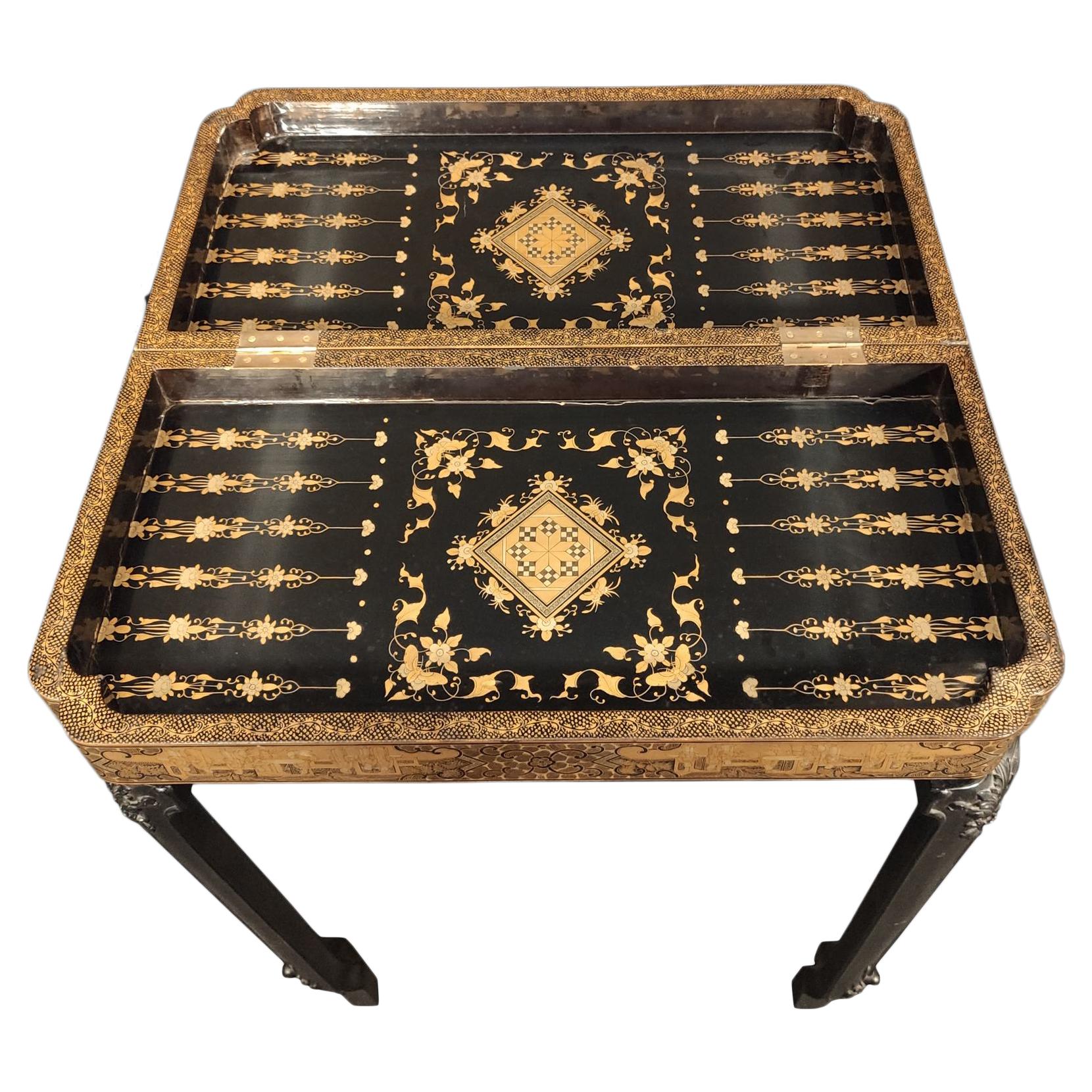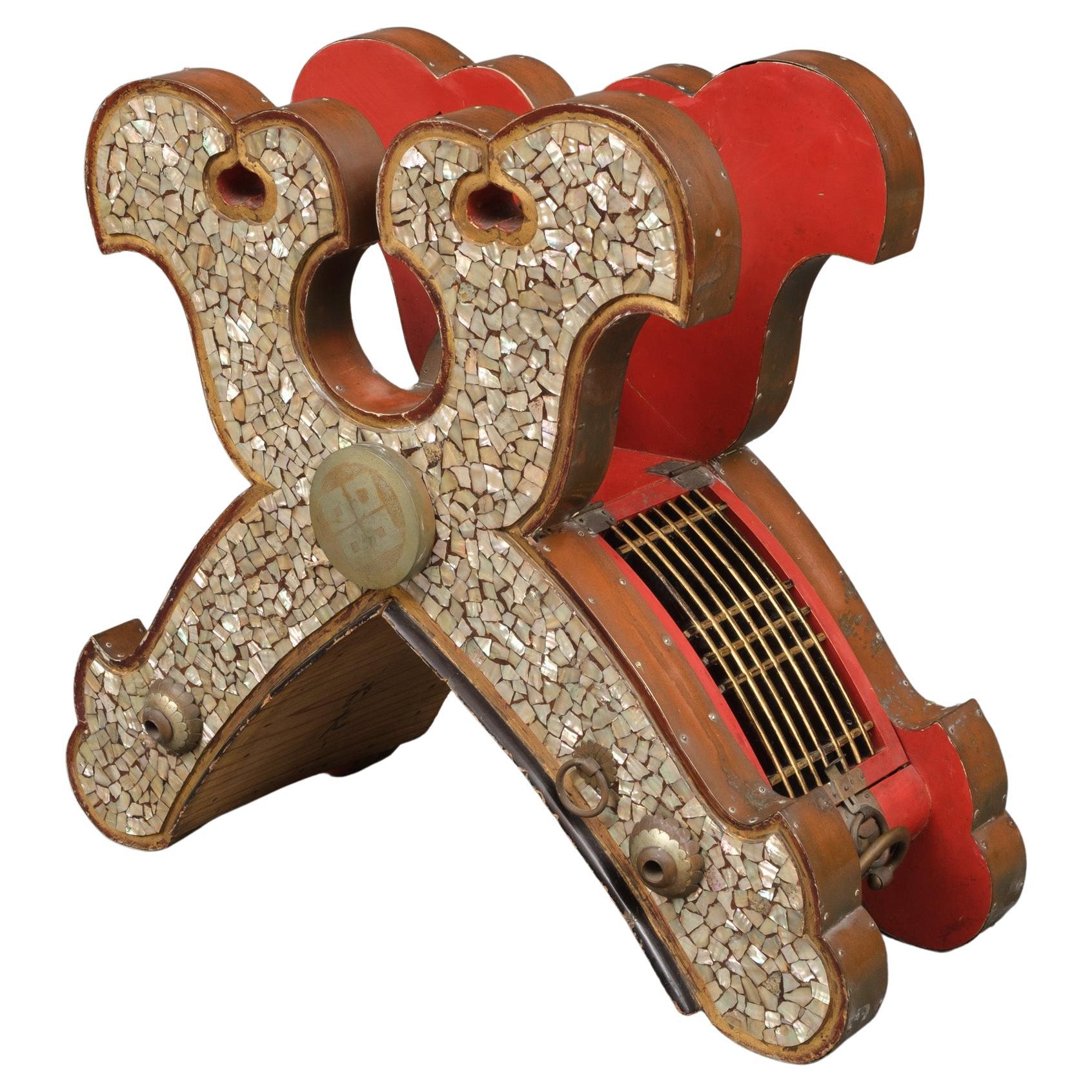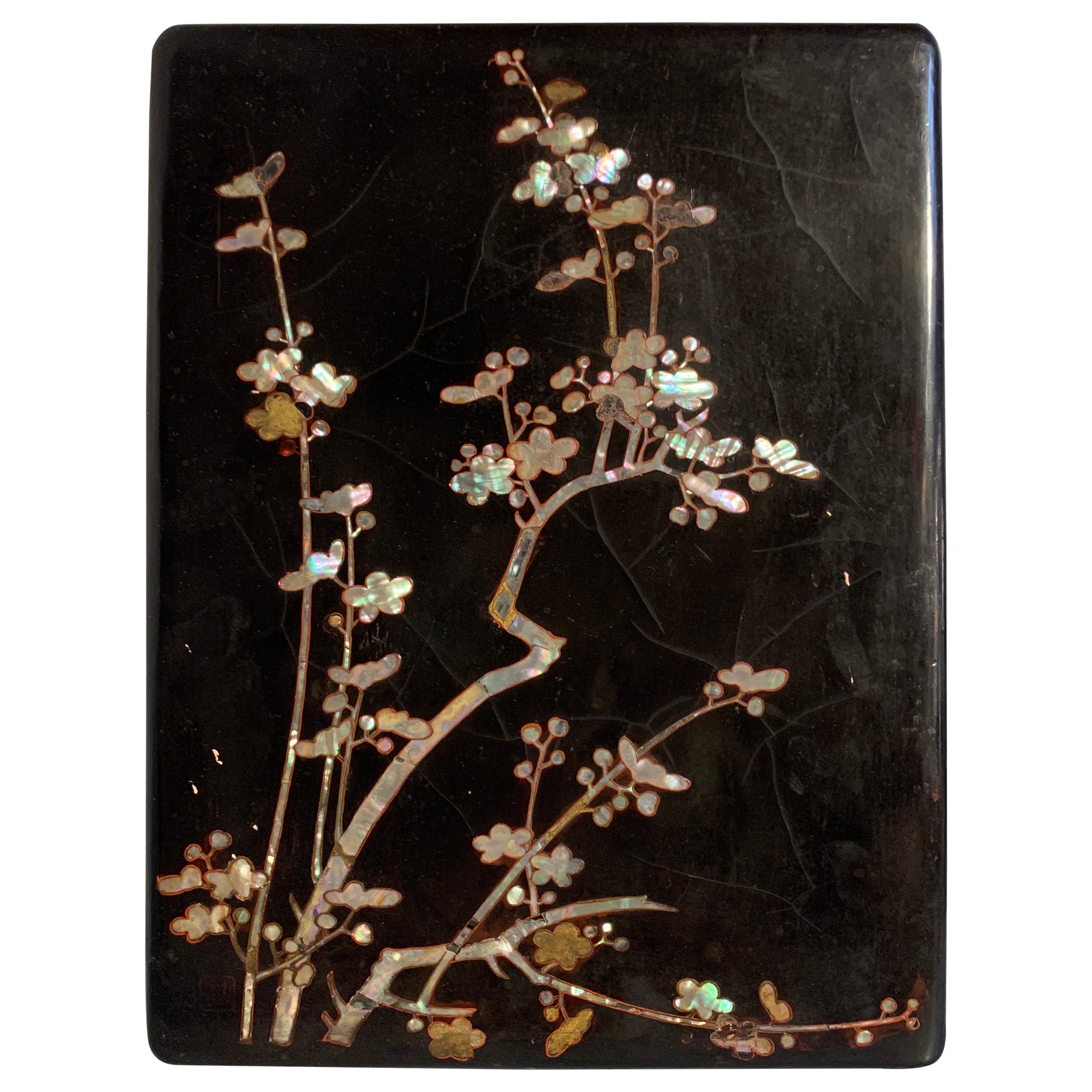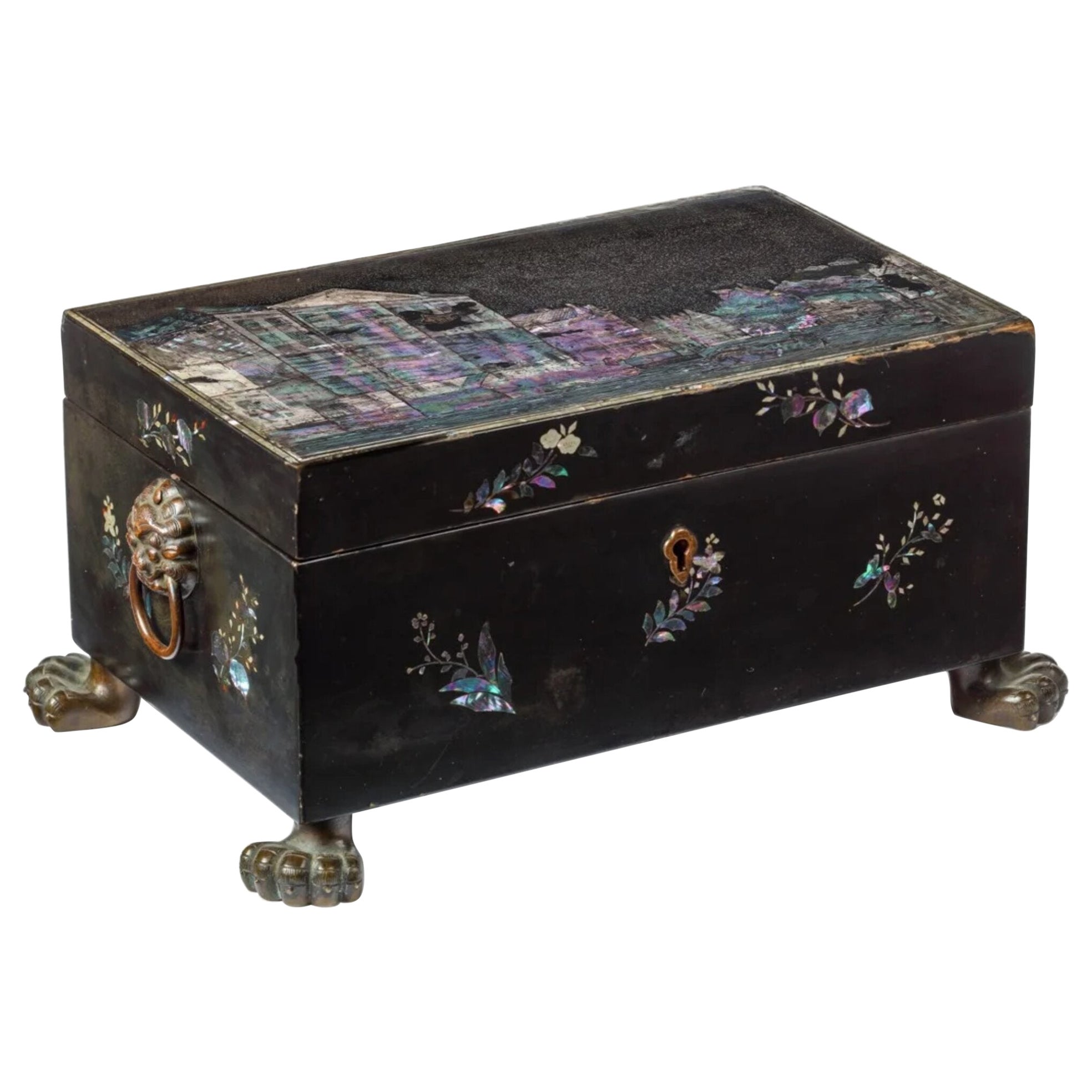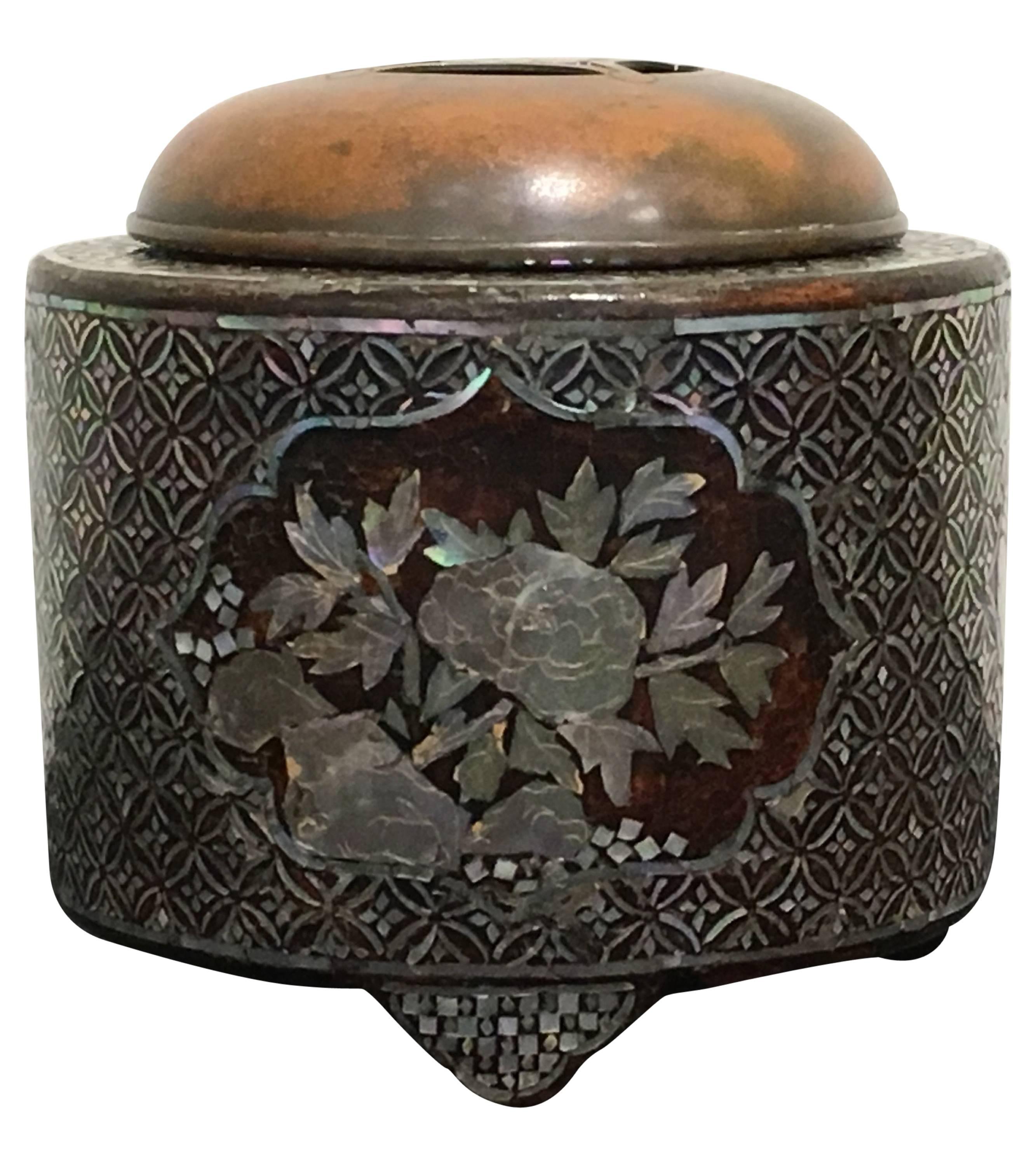Items Similar to Mother-of-Pearl Black Lacquer Japanese Export Table with Feet Shaped as Bats
Want more images or videos?
Request additional images or videos from the seller
1 of 7
Mother-of-Pearl Black Lacquer Japanese Export Table with Feet Shaped as Bats
About the Item
A Japanese export lacquer tripod table with feet shaped as bats
Nagasaki, 1850-1860
H. 73 x diam. 108 cm
The six-lobbed top is decorated with reverse-painted mother-of-pearl in a sprawling motif of plum blossom, bamboo, and peonies, surrounded by fluttering sparrows enhanced by details in maki-e.
The table, made to appeal to a foreign audience, incorporates a curious mixture of seasonal references. In addition to the decoration of foliage from late winter and spring, the column is decorated with grapes and a rabbit pounding rice, both Japanese motifs for autumn and the month of September. The feet, shaped like bats that almost appear to wake up from hibernation, symbolise luck and happiness in Japan.
The present flamboyant Nagasaki-style table is depicted in the Asada workshop drawings of 1856. These drawings, titled Aogai makie hiinagata hikae (memorandum of designs for lacquer with inlaid pearl shell) are unique documentation of Nagasaki lacquerware. They show a range of designs for the fashion of furniture and smaller items for export from the late Edo period. The Asada drawings can be found in The Nagasaki City Museum. Other pieces from the same design papers are in the collections of the Peabody Essex Museum in Salem and in the Tokyo Museum of Natural History. (Japanese Export Lacquer 1580-1850, Oliver Impey and Christiaan Jo¨rg, Hotei Publishing 2005, p. 267 and 273).
The table appears to be the same as the one exhibited at the Gallery of the Royal Society of Painters in Watercolour on Pall Mall, London, in 1854, which is shown in an engraving of exhibited Japanese furniture in the Illustrated London News of 2 February 1854.
A similar table with legs shaped as butterflies is in the collection of the Peabody Essex Museum (inv. E62273).
- Dimensions:Height: 28.75 in (73 cm)Diameter: 42.52 in (108 cm)
- Materials and Techniques:Lacquer,Lacquered
- Place of Origin:
- Period:
- Date of Manufacture:1850-1860
- Condition:Wear consistent with age and use. There is an additional option to have this table made flawless. Our restorer can add a final layer to impregnate the black lacquer. It might take some time. We did not do this in advance, since some people like it to have it with traces of age.
- Seller Location:Amsterdam, NL
- Reference Number:1stDibs: LU5458233887412
About the Seller
5.0
Vetted Seller
These experienced sellers undergo a comprehensive evaluation by our team of in-house experts.
Established in 1985
1stDibs seller since 2020
19 sales on 1stDibs
Typical response time: 3 hours
- ShippingRetrieving quote...Ships From: Amsterdam, Netherlands
- Return PolicyA return for this item may be initiated within 7 days of delivery.
More From This SellerView All
- Japanese Nagasaki Export Lacquer Box with Depiction of the 'Trippenhuis'Located in Amsterdam, NLA Japanese Nagasaki export lacquer box with mother-of-pearl depiction of the Amsterdam ‘Trippenhuis’ Edo-period, circa 1830 H. 12.5 x W. 24 x D. 15 cm ? The house depicted on t...Category
Antique 19th Century Japanese Edo Lacquer
MaterialsMother-of-Pearl, Lacquer
- A Japanese export lacquer box with depiction of the Grand Hotel, YokohamaLocated in Amsterdam, NLMeiji period, circa 1873-1887 The black lacquered box decorated in maki-e and hiramaki-e gold, with on the lid a European style building complex and several Japanese and European figures walking along a street in the foreground. The sides are finely decorated with several insects and the inside with several compartments and nashiji decoration. H. 7.4 x W. 29 x D. 25.7 cm After the Americans forced Japan to open their harbours to the outside world and take part in international treaty and trade around the mid 19th century, the formerly feudal society rapidly changed. Japan was now focussing on an industrial future. One of the major international ports was Yokohama with its foreign embassies and warehouses - which attracted a great number of visitors of all sorts. For the higher society visiting Japan for the first time a new and ‘Western’ hotel had to be realised; hence the construction of The Grand Hotel on Kaigandori. The hotel was opened on August 16, 1873 (Meiji 6) and was soon considered the height of Western culture and elegance in Japan. The building probably depicted on this box, designed by American architect Richard P. Bridgens (リチャード・ブリジェンス, 1819 -1891), is the original hotel...Category
Antique 19th Century Japanese Lacquer
MaterialsGold
- Japanese Export Nagasaki Lacquer Box with the Portrait of Napoleon BonaparteLocated in Amsterdam, NLA Japanese export Nagasaki lacquer tobacco box with the portrait of Napoleon Bonaparte Edo-period, circa 1810 The box in black lacquer on copper, ...Category
Antique 19th Century Japanese Edo Lacquer
MaterialsCopper, Gold
- A rare Japanese Namban export lacquer coffer with Mon emblemsLocated in Amsterdam, NLLate Momoyama period, late 16th century The coffer is decorated in black lacquer, urushi, on cedar wood, decorated with gold dust and silver, maki-e, and nashiji, mother-of-pearl, r...Category
Antique 16th Century Japanese Lacquer
MaterialsSilver, Copper
- Pair of Japanese Lacquer and Mother-of-Pearl Inlaid Knife Urns, circa 1800-1815Located in Amsterdam, NLA rare pair of Kyoto-Nagasaki style lacquer and mother-of-pearl inlaid knife urns Edo period, early 19th century Measures: Height 71 x diameter 30 cm ?Formed as urns with vertically lifting covers and elongated finials, revealing fitted green velvet lined interiors for knives, decorated overall with birds, flowering stems, faux-fluting and oval panels with landscapes. The square plinth is raised on four bracket feet. Inside the lifting cover of one of the urns are Japanese characters, supposedly indications of some code by the craftsman. A closely related knife urn, now in the collection of the Peabody Essex Museum, Salem (inv. E 73115), was acquired in Nagasaki by Captain Samuel Gardner Derby of the Margareth of Salem in 1801. Captain Gardner Derby traded in Nagasaki under charter from the VOC (Vereenigde Oostindische Compagnie), the Dutch East India Company. Between 1797 and 1814 Holland was occupied by the French and from 1811 until 1816 Java by the English. During these periods practically no Dutch shipping was possible between Holland and Batavia (Jakarta) or between Batavia (Jakarta) and Nagasaki. To maintain a minimum amount of shipping between Batavia (Jakarta) and Nagasaki, between 1797 and 1807, the VOC chartered mainly American ships. American captains and officers ordered and bought mainly lacquered furniture in an American-English style, completely different from what the Dutch up till then had ordered. The present knife urns were possibly also ordered and acquired by Captain Gardner Derby during his stay in Deshima/Nagasaki in 1801. Another similarly neoclassical shaped knife urn in the collection of the Ashmolean Museum Oxford (inv. 1996.17) appears to be signed by woodworker Kiyotomo koreo tsukuru (Kiyomoto made this). The same name, together with an address in the Sanjo-Teramachi District of Kyoto, has been found inside a fragmentary urn in a private collection. This is an indication that European-style furniture was not only lacquered in Japan but made there as well. This undoubtedly is not only true for knife-urns, but all European- style furniture lacquered in Japan after circa 1800 was made by Japanese furniture makers...Category
Antique Early 19th Century Japanese Anglo-Japanese Lacquer
MaterialsBrass
- Fine Japanese Export Red Lacquer Box with Masonic Symbols, circa 1800Located in Amsterdam, NLA fine Japanese export red lacquer box with Masonic symbols Kyoto/Nagasaki, 1800-1820 Red lacquer decorated with scattered flowers and flying birds with long tails in gold, wit...Category
Antique Early 19th Century Japanese Edo Lacquer
MaterialsGold
You May Also Like
- Chinese Export Lacquered and Mother-of-Pearl Chess Board from 19th with a TableBy Gold ChinaLocated in Madrid, ESChinese Export lacquered and mother-of-pearl chess board from 19th with a table carved wood stand. Size: 58 x 58cm and 73 cm high Very good condition.Category
Antique 19th Century Chinese Chinese Export Lacquer
MaterialsWood
- Red lacquer Festival Flag Support abundantly inlaid with mother-of-pearl, JapanLocated in Amsterdam, NLRare museum-worthy Japanese lacquered wooden festival support for a flag. In feudal Japan this kind of supports sat on the back of a horse or ox during pr...Category
Antique 19th Century Japanese Antiquities
MaterialsMetal, Bronze, Copper
- Japanese Momoyama Period Black Lacquer and Mother of Pearl Box, 16th CenturyLocated in Austin, TXA fine and unusual Japanese black lacquer and mother of pearl inlaid box, Momoyama Period, 16th century, Japan. The large box and cover featu...Category
Antique 16th Century Japanese Edo Lacquer
MaterialsAbalone, Lacquer
- Antique Chinese Coromandel Black Lacquer Screen with White Mother of PearlLocated in Toronto, ONThis antique Chinese screen features intricate inlaid mother of pearl goddesses. What makes this screen unusual is the grand scale of the design of the figures. The screen is lacquered in black and entirely hand painted. The reverse side of the screen is also hand painted. The screen can be used as a room divider or headboard. Coromandel lacquer screens...Category
Early 20th Century Chinese Lacquer
MaterialsMother-of-Pearl, Lacquer, Wood
- Japanese Edo Period Lacquer and Mother-of-Pearl Embellished Stoneware KoroLocated in Austin, TXA highly unusual Japanese crackle glazed koro (incense burner or censer), lacquered and inlaid with mother-of-pearl embellishment, signed Gyokusen, Ed...Category
Antique 19th Century Japanese Edo Scholar's Objects
MaterialsCopper
- Japanese, Black Lacquer, Chrysanthemum Shaped Incense Burner 'Koro'Located in Hudson, NYWith chrysanthemum motif and a gilded bronze lid. Includes unsigned collector's box. Interior measurements: 7 1/2" opening, 5 1/4" deep.Category
Antique Late 18th Century Japanese Lacquer
MaterialsLacquer
Recently Viewed
View AllMore Ways To Browse
Asian Watercolor Butterfly
Antique Wake Table
Peony Engraving
Japanese Makie Lacquer
Makie Lacquer
Antique Table Salem
Salem Table
Japanese Antique Bento
Vintage Japanese Bento Box
Japanese Tanzaku
Suzuki Silver
Burmese Lacquerware Betel Box
Burmese Yun
Chinese Chippendale Jewelry Box
Manju Netsuke
Pagan Bya
Temple Ranma Panel
Antique Korean Black Lacquer Mother Of Pearl
